Elizabeth Broadbent's Blog, page 2
May 13, 2024
Interview with Kate Maruyama
You’ve published several horror works— Bleak Houses , which is two novellas; the novel Harrowgate (blurbed by Lemony Snickett!), Halloween Beyond: Gentleman’s Suit , and now you have The Collective coming out—and I know I’m missing somethings here. Can you talk a little about your writing journey?
I never know where I’m writing from ‘til I’m in it, sometimes when I finish! Harrowgate was set in New York, as that was the city I grew up with. I was writing from a very specific place of loss and made a story of a man whose wife and kid were dead and living with him. I thought I was writing a love story, so didn’t know it was horror until it sold as a horror novel! Then I was like, oh yeah, dead people, a demon-type doula, I guess it is horror! Boy am I glad it was--it opened up a thriving, supportive community for me.
I adore horror writers! Since then, I’ve been writing in horror, science fiction, and nongenre, whatever the story demands. I thought another book I was writing would be magic realism, but it ended up straight realism. Started another book in realism that ended up horror. To answer your question, I guess the journey has just been write forward. And there are happy surprises along the way. Like ending up at Raw Dog Screaming Press with Bleak Houses which is how I met you! Through some work in the LA writing community, I met the good folks at Writ Large and now they’re publishing The Collective!
I freaking loved Safer , the first novella in Bleak Houses , which dealt with a nanny working for an unbelievably famous LA family in the middle of the pandemic. Your new novel, The Collective , also deals with Hollywood. Do both come from your own experiences in LA?
I’m setting most things in LA now because it’s such a layered and rich city. I’ve lived here thirty years, and I am still baffled by outside people’s view of it as a subsection of inhabitants who live in a five-mile radius, most of them transplants. I’m always trying to dig deeper, show a lot of neighborhoods. I’m working on stories now in a slightly magical LA that show the history of displacement and neighborhoods here.

You have a new novel coming out— The Collective , which is publishing with non-horror press. I freaking loved it. What do you want readers to know about it?
Thank you for reading it! Despite what I said above, I DID work in the film industry for fifteen plus years and saw some stuff. No actual demons. But I was most interested in film industry folks’ constant search for status and something MORE and everything in place to feed that. The Collective is, if you will, your ticket behind the velvet rope, into the inner workings of production companies, actors, auditioning and the movers and shakers of Hollywood. Only with demons. It’s fun!
That said there are long hard looks at recognizing systems you live in, and how they might help or harm the larger ecosystem. It’s also a look at racism in Hollywood, and learning when you aren’t helping yourself but something larger and maybe more unsavory. I had fun writing it, I hope folks have fun reading it!
You tell parts of The Collective from the perspectives of Jonathan and Curtis, both Black men—and their social positioning as Black men is an important part of the novel. As someone who writes Southern Gothic, race is always on my mind, so can you talk a little bit about how you negotiated that space?
I worked in Hollywood largely in the nineties and it was completely white dude dominated. I had friends of color being treated worse than I was as a white woman—and trust me, I have stories there. I was working at the time of Weinstein. But you can’t show racism in all of its subtleties without characters of color.
I included the story of my friend Damon who was waiting for his car at the valet at a restaurant. A white executive handed him his keys as he rushed into lunch. Damon was there in a nice suit, the VP of production for a major production company, feeling chuffed about a movie he was putting together, and this was the presumption about him. It stuck with me.
I took Jonathan’s story as an executive for a “color blind” white executive to explore the more subtle dangers of working for someone who claims not to see color (Simon is a demon, so race is not important to him) to explore how even when you’re in, you’re not fully in. And how white people claiming to be championing people of color can be their own kind of danger.
Curtis is also Black because the friendship/mentorship between him and Jonathan seemed most important to the story. But the story between Jonathan and Simon is more about the dangers of loving and putting one’s faith in a narcissist. And Simon not “seeing” color is another way of exploring Simon’s not seeing Jonathan at all. I dug into that specific kind of heartbreak, when you put your belief in someone and your support behind someone because you think they see you, only to realize they are functioning from their own operational reality which has nothing to do with you at all. The power dynamics in this supposedly progressive space are still white supremacist and this story pushes at that in its own way.
Casting couch tropes and the whole Weinstein thing had been done to death, and I guess I was writing from a hopeful space where that maybe has passed in the film industry? I wanted Sophia’s space to step outside those power dynamics (although there are some questions around sex) into different questions about working within a system and slowly waking up to it.
I also found The Collective interesting for its emphasis on setting—non-Angelenos don’t often think about LA as a place as much as a concept. What led you to emphasize setting so much?
Yes! Again, many notions of this city are created by a very small demographic of transplants who work in film. I wanted to capture downtown LA in its layers of displacement, the natural beauty of the city and it surrounding hills, and this entire world going on outside the film industry, even though the story centers on the industry itself.
You have an interesting distribution plan in place for The Collective. Can you tell us a little bit about it?
Yes! Writ Large Press, who are always looking at publishing in new and interesting ways, has released the book as a serial. For ten bucks, folks can subscribe to the book as a newsletter, and get new installments every week for thirteen weeks! The physical book comes out later this year (I believe at a discount for those who’ve subscribed). It may also be released as a podcast somewhere down the road.
I teach writing and I’m trying to educate my students about the many different ways in which you can get your words to people. Writ Large is exploring all those ways. I’m excited to see how this goes and report back to my students. There are so many models outside of traditional publishing now, and so many kinds of readers, I’m looking forward to this.
I’m so excited about this book for you. And I know you have a whole team of cheerleaders behind you—Women Who Submit. Who are they and what do they do?
Women Who Submit is an amazing organization founded by fellow graduates of Antioch University’s MFA program. I’ve been a proud member of their board for two years now, but a member since its inception. “Women Who Submit seeks to empower women and nonbinary writers by creating physical and virtual spaces for sharing information, supporting and encouraging submissions to literary journals, and clarifying the submission and publication process.” Basically we create support systems, share resources, and support women writers in our area. There are dozens of chapters all around the country now and the best thing about it is it’s grassroots and completely free to members.
We became a nonprofit last year, with the aim of raising money to continue programming for our members (being able to pay presenters is a big deal), including conferences and workshops. There are also grants available to members who apply including The Kit Reed Travel fund, that I created with my brothers in honor of my mom, who was always contributing to writer friends trying to get to writing residencies. Most people don’t understand that residencies, even funded, can be a barrier for folks who can’t afford to pay to travel to them. The Travel Fund is an attempt to close that gap.
I’m grateful to the members of Women Who Submit, because I always have someone to turn to to brainstorm ideas for how to promote a book, get the word out, or even, after yesterday’s workshop, how to get books into libraries! We had a panel of librarians from universities, to public libraries, to a grammar school talk about different resources for getting onto library programming or getting books into libraries.
Thanks so much to Kate Maruyama for talking to me about her new novel! You can pick the installments of The Collective at Writ Large.
You know what they say. Move to Hollywood, sell out, lose your soul.Working for a demon is complicated and in his late fifties, Jonathan Hawkins is fighting the waning of his career in ageist, racist Hollywood and is working hard to maintain his relevance in the industry. As Simon Raithe’s devoted right-hand man, producer, and partner of several decades, he named and built the Collective. Jonathan is behind its language, genius, and silenced evil doings.
Still reeling from her mom’s sudden death from cancer, Jenny, 26, has blown off admission to med school and moved to Hollywood to pursue a lifelong dream of acting. When she falls in with the Collective everything begins to change. She becomes an assistant to the charismatic, yet elusive Simon Raithe. As she starts getting auditions, and invitations to exclusive parties, she puts aside any misgivings she may have about secret meetings, and parts of her life into which the Collective seems to seep.
Curtis is intrigued by his weekly dinners at Musso & Frank’s with Simon and his mentor, Jonathan, and decides to write a book on them: the real power in Hollywood, the unpinnable, ineffable Simon Raithe. But as he begins his research, their stories reveal holes and dark spots including the mysterious disappearance of an old friend. He has no choice but to dig further. What he uncovers could topple the entire organization.
Maruyama weaves a tale of intrigue, evil, and stardust as she takes you behind the velvet ropes of the film industry into its darkest recesses.
Thanks for reading Feral Swamp Life! Subscribe for free to receive new posts and read about horror, writing, and creativity!
May 6, 2024
Blue Jay Inspiration
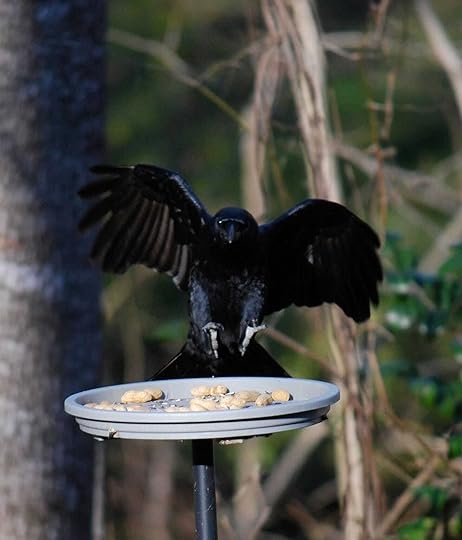 You know you’re old when …
You know you’re old when …There’s a joke somewhere about being old when you get very excited by seeing a yellow-rumped warbler. Concidentally, we saw the meme online the day after my husband snapped a picture of one in our yard, and he felt both attacked and seen. Once we started feeding crows via platform feeder, small birds began mobbing our feeder and suet stations. So far this year, my Merlin app, which recognizes birds by song, has recorded over forty different species in our yard, including every native woodpecker (seven or so) and rarely-seen cedar waxwings.
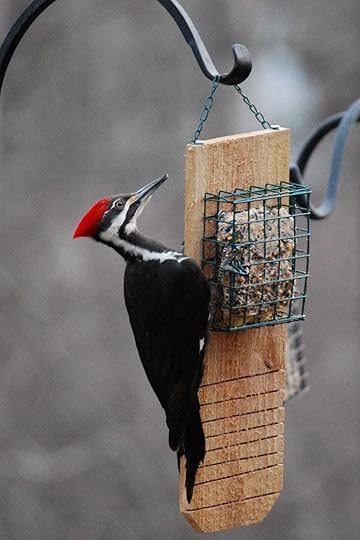
Once the tiny birds started showing up, we got really into bird watching. Late last year, we converted our seldom-used dining room to something I call a writing room and my husband has dubbed “The Reznorium” (so what if I insist on displaying my alligator skull? One of the best purchases ever). Because our house is built on a hill, the room’s windows look out on the yard from about twenty feet up, which gives the whole thing a whiff of treehouse-ishness.
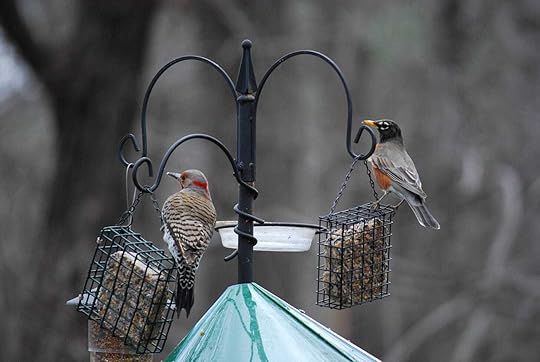
Converting that room gave us a prime view of the bird feeders. Really, the tiny dinosaur drama does wonders for my mental health. Bluebirds battle cardinals; the Carolina wrens have a disconcerting tendency to stand back and watch others birds fight, like tiny spectators at a fight club. The chickadees and titmice spent two weeks fighting over one of our birdhouses. Since the chickadees won, the titmice are currently nesting in my deck railing. They’re nearly murderous with rage if we venture too close.
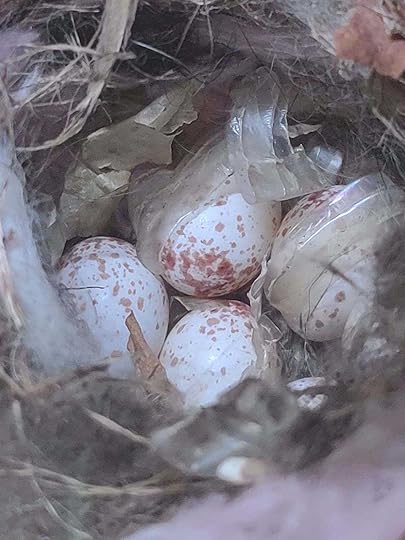
If this old age, I’m here for it.
Of course, life spilled into writingWith all this brainpower devoted to birds—watching them, learning their songs, snapping their photos—birds were bound to bleed into my writing. After I finished Ninety-Eight Sabers, I got desperately stuck. Plots came and went; I’d write five thousand words, ten thousand words, then abandon them, convinced I couldn’t possibly bring their story to a satisfying conclusion. This went on for a month. I felt like I was wasting time and going crazy in the process. I’m not fun to live with in between writing projects.
Caleb Stephens (author of The Girls in the Cabin and Feeders) rescued me. He taught me the fool’s cap method of outlining a novel, something I’d never learned in three years of an MFA program. Caleb really ought to farm himself out for classes—as a thriller author, he has a fantastic grip on action and plot progression, and this trick saved my sanity. That night, I pulled out some notebook paper and outlined a novel.
I married two of my then-obsessions, #kategate and birds (specifically blue jays). I couldn’t stop imagining that the sinister royal family had trapped Kate Middleton in Buckingham Palace, holding her hostage until she agreed to compliance. It seemed all too plausible. And I couldn’t get those little birds out of my head. Blue jays are consummate mimics—mine regularly imitate hawks, wrens, car alarms, and lawnmowers—and that got me thinking.
So I outlined what’s becoming a novel called Bluefeather.
It had a rocky start; I have a habit of trying to get beginnings perfect, since they color everything that comes after. Three rewrites of the first 10K words later, I’m finally chugging along. A month after Caleb helped me outline the novel, I’m sitting at 30K. Not bad!
… and as I typed Caleb’s name, I accidentally typed “Caelum,” the name of Bluefeather’s main character, and now I’m wondering if there’s any connection there, though I picked the name for very specific reasons that had nothing to do with him. We’ll call it a gesture of unconscious gratitude.
Life is going really well since AuthorCon.I’m not only grateful that I managed to start another novel (probably about a week before the convention?), I also have super-big news I can’t reveal yet, so stay tuned! Til then, I’ll be working on Bluefeather and watching my birds.
What I’m reading: Mostly novellas for my StokerCon panel. I really enjoyed both Zachary Ashford’s When the Cicadas Stop Singing and V. Castro’s Hairspray and Switchblades. Currently taking a break with Michael McDowell’s Blackwater and The Night Circus before I keep going.
What I’m watching: Jack Osborne’s Portals to Hell, which includes some stellar ghosthunting. I never would have believed that the most authentic-seeming ghost reality TV would include Ozzy’s son, but life is stranger than fiction. Also watching Skinwalker Ranch on Tuesdays, which unlike Portals to Hell, actually does include portals. Since the previous season, when the team’s GPS lost a quarter second, I’ve been utterly hooked—see Ninety-Eight Sabers for evidence.
What I’m excited about: Other than my novel and the afforementioned News I Can’t Talk About, I’m super psyched for the new team to take over DarkLit! Evelyn Freeling’s a good friend of mine, and I can’t wait to see what she and the rest of the team have in store. Also excited that the trees have leaves again; StokerCon is coming up; and there’s a crow yelling at me right now. Also, my hammock.

April 16, 2024
Ink Vine Release Weekend!
First, a huge thank you to everyone at Undertaker Books—Cyan LeBlanc, D. L. Winchester, and especially editor Rebecca Cuthbert—who worked hard behind me to make Ink Vine a huge success this past weekend! We watched all day as this happened in the LGBTQ+ catagory…

And this!
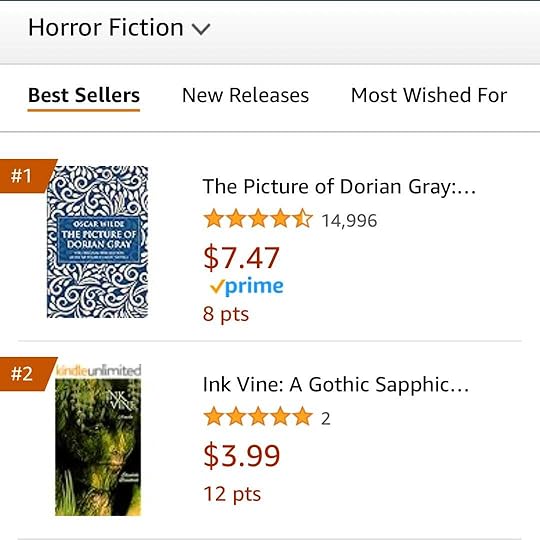
The very best part? I was at Scares that Care AuthorCon in Williamsburg, so all my friends got to celebrate with me—including my editor—as Ink Vine climbed the charts.
 Me, editor Rebecca Cuthbert, Evelyn Freeling
Me, editor Rebecca Cuthbert, Evelyn Freeling
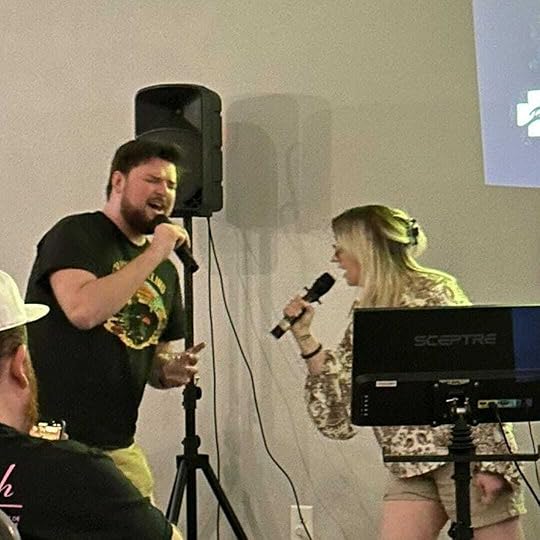 Me and Sam Rebelstein singing “Under Pressure.” I insisted on singing Bowie. Bonus: Sam could actually hit Freddy Mercury’s notes. I made up for it in enthusiasm.
Me and Sam Rebelstein singing “Under Pressure.” I insisted on singing Bowie. Bonus: Sam could actually hit Freddy Mercury’s notes. I made up for it in enthusiasm.
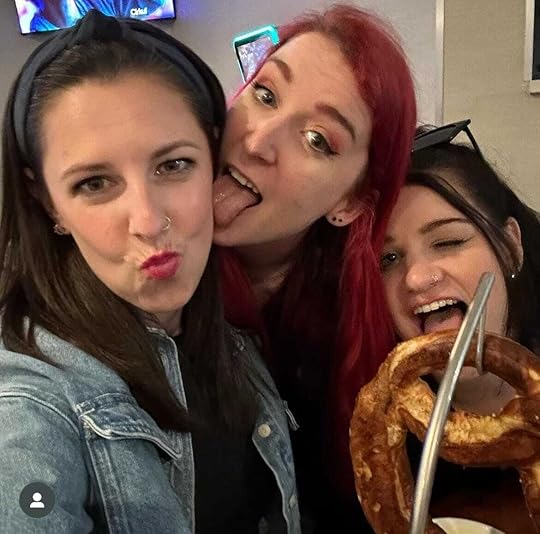 The awesome girls! Chelsea Pumpkins, P.L. McMillan, and Evelyn Freeling
The awesome girls! Chelsea Pumpkins, P.L. McMillan, and Evelyn Freeling
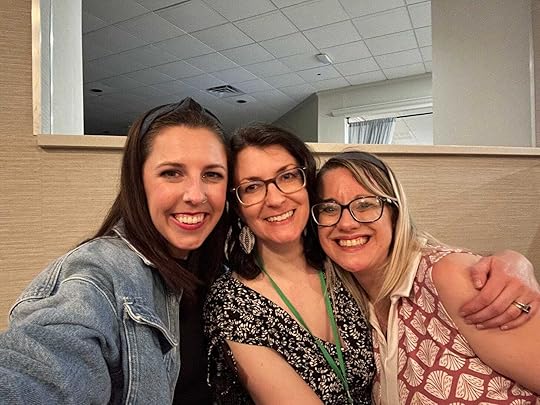 Chelsea, Rebecca, and me
Chelsea, Rebecca, and meThen this happened …
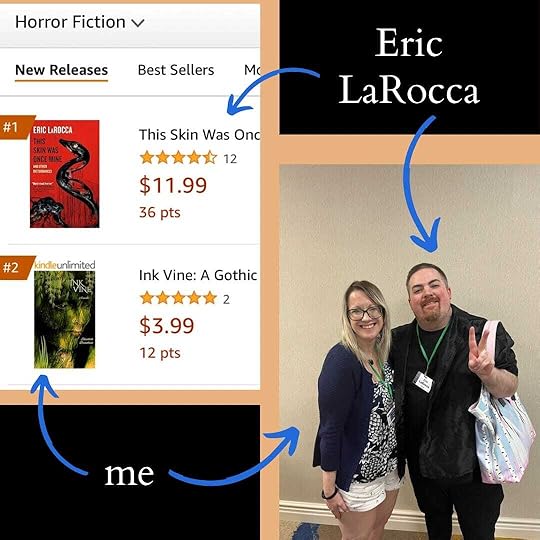
Eeek! Could I have asked for a better release weekend?! I had one more thing to do… finish selling my almost-thirty copies of Ink Vine.

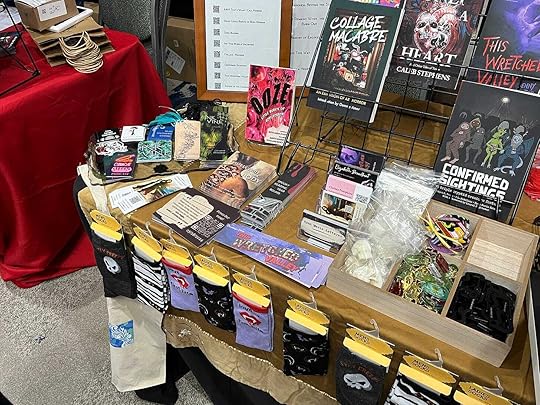 Between me, Rebecca, Chelsea, Pam, Ryan, and Jenny Kiefer, we had an epic amount of swag. Thanks to Jenny at Butcher Cabin Books!
Between me, Rebecca, Chelsea, Pam, Ryan, and Jenny Kiefer, we had an epic amount of swag. Thanks to Jenny at Butcher Cabin Books!But finally, on Sunday…
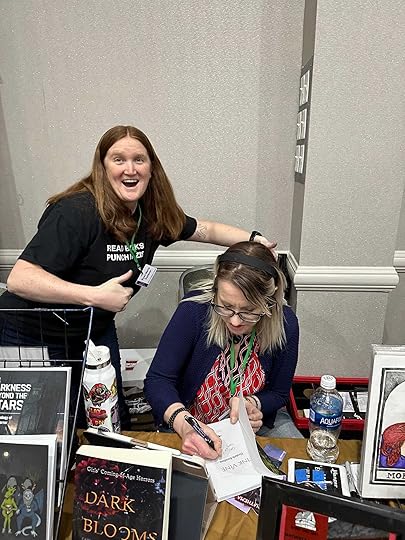
Ryan Marie Ketterer sold the last copy of Ink Vine three hours before the vendor room closed! Here I am signing it for the reader, because Chelsea Pumpkins is a goddess and snapped this fantastic pic. I’m surround by rock stars. I’m also missing pics of Vin and Johnny and Jenny …
About a year ago, I reviewed Aah! That’s What I Call Horror for Wrong Publishing. As I read it (because it was a fantastic anthology—eventually longlisted for a Stoker), I tweeted about each story. I figured I was being ridiculous and over-enthusiastic, but the authors were so appreciative. Ryan Marie Ketterer contacted me to review Collage Macabre. I did the same thing again, and now? I’m friends with all these people—all these amazing authors I loved. And they were there cheering me on this weekend (we desperately missed everyone who couldn’t make it, especially Brett Mitchell Kent and TJ Price; the list of the rest of you is way too long but you all know who you are … Christi and Rae and Caitlin and Jolie and Ai and Andrew and Carson and Emma and God, I’m still missing people, but all of you were invoked and missed at some point).
Who gets that lucky?!
Okay, I’m going before I cry over a Patreon post. I’m so grateful to every single one of you. If you read Ink Vine and liked it, reviews are open on both Goodreads and Amazon—do a writer a solid, especially if you grabbed an ARC <3
Book News …Brett Mitchell Kent’s Whispers of Apple Blossoms drops on May 1! A masterpiece of grief horror, the book is fanastic—I was lucky enough to read an ARC, and after I did, I blurbed it for him. I’m not going to ruin the surprise of what I said, but it was very, very good.
Welcome to Your Body: Essays in Evisceration comes out May 28. Edited by Ryan Marie Ketterer, it includes stories by Alex Wolfgang, Ai Jiang, Mary Rajotte, Julie Sevens, Christopher O'Halloran, Sasha Brown, Bridget D. Brave, Taylor Ketterer, Demi-Louise Blackburn, Lindsey Ragsdale, Emma E. Murray, Johnathon Heart, P.L. McMillan, Rachel Searcey, Bryan Young, Kai Delmas, and David Worn, and a foreword from Paula D. Ashe. That’s a star-studded cast if I ever saw one. Preorders are open now!
Emma Murray’s When the Devil, which I read this past weekend, drops on May 7. If you’re a fan of Ink Vine, you’ll love it. It’s sapphic, Southern, and sexy… and it’s a great freaking read. Pick it up in preorder.
April 3, 2024
Ink Vine: Coming April 12 with Undertaker Books
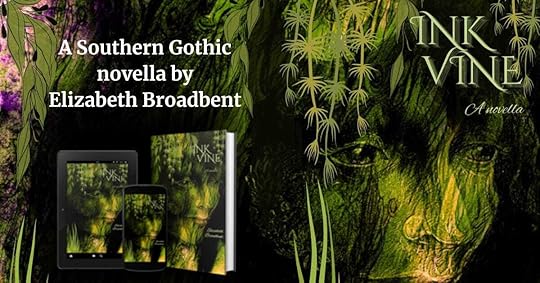
I’m so excited to bring Ink Vine into the world. Even better, the publisher working with me is the team that brought the book into being. Undertaker Books is a phenomenal little press brought to you by none other than Cyan Leblanc and Joe Stout, who did a huge amount of work on the book, and editor-in-chief Rebecca Cuthbert, who midwifed this book from ten thousand words to a full-blown novella. I’m so lucky to be part of an amazingly talented, motivated, and engaged team.
Under their watch, Ink Vine is now available for preorder on Amazon; the Goodreads page is up and running, and we already have (as of this writing) nine reviews! (Don’t worry; if you pre-ordered through me, I have the books ready to go, and they’ll be sent out in a few days).
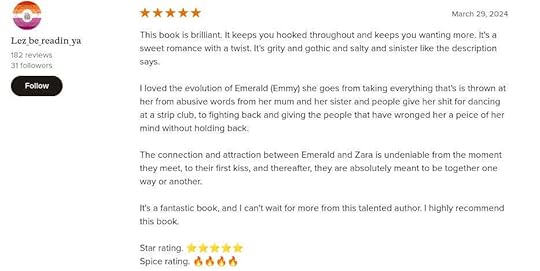
It’s so exciting to work with Cyan, Joe, and Rebecca. Facebook ads are up and running. There’s a great blog post about the book on Undertaker’s site. Amazon’s A+ content is working its way through the pipeline, though we already have some up on the page (check the pretty graphics under “From the Publisher”). There’s a new blurb from Brett Mitchell Kent, one of my favorite authors—stay tuned for a review of his book, Whispers of Apple Blossoms, coming in April.
Speaking of Brett, his review of Ink Vine on TikTok made me cry:
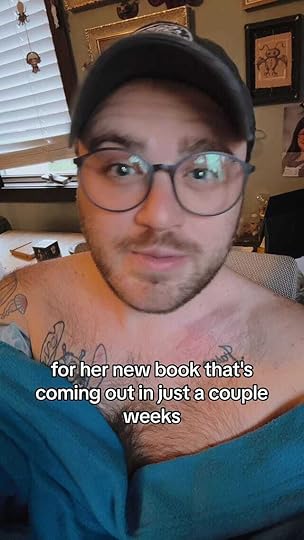 @hoagiehausenCould not wait a single second longer to gush about this book I read by @Eliza Broadbent 😱😱😱😱😱😱 I absolutely LOVED it. It has me on a high right now because it was just exactly what I needed. 50/5 stars. I recommend. #booktok #bookcommunity #bookreconmendations #tbr #arcreader #horror #[image error]Tiktok failed to load.
@hoagiehausenCould not wait a single second longer to gush about this book I read by @Eliza Broadbent 😱😱😱😱😱😱 I absolutely LOVED it. It has me on a high right now because it was just exactly what I needed. 50/5 stars. I recommend. #booktok #bookcommunity #bookreconmendations #tbr #arcreader #horror #[image error]Tiktok failed to load.Enable 3rd party cookies or use another browser
He nailed it. This is why I wrote the book, and this is what I hope people get from it. Total teary meltdown when I finished it!
Ink Vine will be live on April 12, both in ebook and paperback; you can preorder the ebook now. It’ll also be on Kindle Unlimited, so if you have KU, pop over and pre-load it! I’m super-glad we decided to go KU; as a debut author with several books in the pipeline, a book available on Kindle Unlimited will not only help sell in both horror and sapphic circles, it’ll be a great preview of my other work.
Thanks one more time to the awesome team at Undertaker Books!
… and you want to follow them on Facebook. Trust me. Ink Vine’s only the start of a great thing. Wait til you who else is coming …
March 15, 2024
Howls from the Scene of the Crime Interview

It’s Kickstarter time! We here at Casa del Broadbent are major fans of anthologies from Howl Society Press. I reviewed Howls from the Wreckage for Wrong Publishing, and we’re all read Howls from the Dark Ages and Howls from Hell. Broadbent Jr. recently stole all three during his tenure as a page at the Virginia House of Delegates and tore through them.
Thanks for reading Feral Swamp Life! Subscribe for free to receive new posts and support my work.
“these stories r amazing,” he texted me one night at seven pm.
It’s Kickstarter time! We here at Casa del Broadbent are major fans of anthologies from Howl Society Press. I reviewed Howls from the Wreckage for Wrong Publishing, and we’re all read Howls from the Dark Ages and Howls from Hell. Broadbent Jr. recently stole all three during his tenure as a page at the Virginia House of Delegates and tore through them.
“these stories r amazing,” he texted me one night at seven pm.
“Are you reading horror during study hall again?” I asked. He was supposed to be doing math. He’s homeschooled. We work hard to maintain a veneer of respectability.
“I told you, it’s modern american lit,” he replied.
Broadbent Jr., along with his dad and me, is eagerly watching the Kickstarter funding for Howl Society Press’s newest venture, Howls from the Scene of the Crime: A Crime Horror Anthology. “An illustrated collection of 22 new short stories of transgressions and lawlessness laced in blood, secrets, and occult compulsions,” it sounds like the fix I’ve been jonesing for since True Detective ended a few weeks ago.
Editor Jessica Peter set down her legendary lists to talk about the anthology, and she dragged her co-editor, the fantastic Timaeus Bloom, along with her.
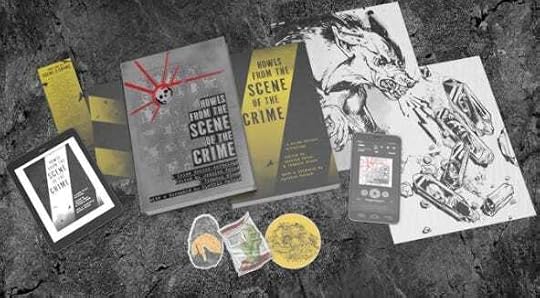
This is the fourth anthology from Howl Society Press. Each anthology has had a different editor with their own flavor and tastes. What unique strengths do you two bring to the table?
TIM: Good question, and I think this is something particularly interesting when it comes to working with a co-editor. I think Jessica especially has a very good eye for the kind of stories that will resonate with large groups of people, with a wider "community" that may be outside of horror. It was really interesting to hear her give her take on how she would feel regarding certain stories if she was reading the anthology outside of the lens of being an editor. I, on the other hand, really love spec stories broadly so it was a major interest of mine to bring in things that crossed genres or were a bit (or maybe more than a bit!) off the beaten path. I think both of us, really, are good at handling the process of editing delicately. Encouraging a writer and their story, but also keeping their word baby intact as they envisioned. I’ll also say, pushing Jess to speak on this more, that she is INCREDIBLY good at planning. I am… well let’s just say I’m a yellow notepad type of guy.
JESSICA: Ha, yes - I am excessively structured (anyone who knows me well knows about my LISTS), and I think it helped the process, and Tim is always fighting for the underdog and for fairness in things like representation, remuneration, etc. which both made the anthology stronger and our processes more equitable.
Your lists are a thing of legend. Seriously.
How did you pick the stories?
JESSICA: We made a rating spreadsheet where we each made notes about every story, and rated them all on a 5-option scale (Loved it, Liked it, Neutral, Didn’t Like It, and Veto). Then when they were all rated, we had a live voice meeting to hash it all out. We discovered our tastes were somewhat similar, but just divergent enough to have to really discuss some stories, which I feel really strengthened the anthology in the long run. In addition to just how much we liked the stories, we focused on how well they would fit together, how well they fit the theme (was it both crime and horror?), and just making sure we didn’t end up with every story having the same crime or horror elements.
TIM: I’d agree– we were pretty in sync with our choices! I was actually surprised with how compatible we were when it came to finalizing stories. I’ve joked more than once that we were TOO compatible. Made for a wonderful project, but for the film adaptation I think we’ll need to bend some truths and add drama for it to be more entertaining for future editors.
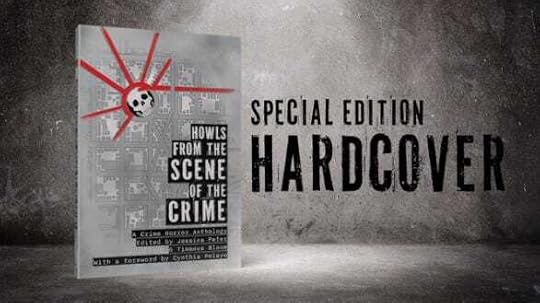
Oh my gosh, a film adaptation would be amazing, shut up. I need that in my life. What were some of the challenges you encountered as editors?
TIM: Oh, boy, Eliza. I put on my pants one arm at a time like anyone else, but “rejections” are always tough. I hate it, maybe. HOWLS is such a particular case with its anthologies because the people submitting are your friends–and everyone is so damn talented. When considering your average call, the chances are much higher–but still, not everyone can get in. As much as getting a rejection sucks, sending one to someone you know and respect is, by my account, the worst.
JESSICA: Absolutely agreed on how hard it is to send rejections to people you know and respect. That sucked! And then of course all the fiddly work that goes into an anthology that aren’t the fun parts where actually you’re dealing with stories can be challenging too.
I won’t ask you to pick a favorite, because that’s like asking me to pick a favorite child. Instead, what are some of your favorite things that different stories accomplish (no spoilers!) and how do you think they accomplish them?
TIM: I think Michelle Tang’s story is a great example of taking the subject matter of crime and placing it elsewhere, away from “here” while mixing in magic and intrigue. Michelle’s lyrical prose is a highlight, and it fits a secondary world narrative so well, as if the words itself reflects the “gaslamp” nature of it. RSL’s “Consummation” is not an easy read, it doesn’t hold your hand–but I mean that in the best way possible. It drops you right into the middle of the action and is perfectly told through a Scouse dialect. Additionally, the way the drug is consumed (hah) in the story reads pretty much like its own kind of magic system–which also fits with Michelle’s take on communicating (or not) with the dead. Then there is Ashe Deng’s story. I was not expecting cyberpunk noir horror–but I am completely thrilled that it came! Her story really highlights those classic elements ( “High Tech, Low life” , the overreach of corporations, the negative impact of technological advancement) but is also truly horrifying. And like a good science fiction piece, thought-provoking too.
JESSICA: I’m a sucker for genre blends. We’re already crime and horror, how far can we go!? CB Jones’ “Around the Riverbend” is a good example of a story that hits a whole bunch of vibes at once: adventurous heist, some serious gore, humor, consideration of identity as a man, critique of colonialism, you name it! And it works. Another story that deftly critiques systems and includes heart-wrenching family relationships is Donyae Coles’ “Cartoons” which tracks the insidious grip of something awful on a community. Then I was excited to see some surprises: things I wouldn’t have expected to see after we put up the guidelines. TJ Price’s haunting “Chosen” surprised me with a lack of a single central protagonist or narrator, and the crime being a question, and Lindsey Ragsdale’s “A Rain of Ruin from the Air” also surprises delightfully with the whole piece being formatted as a transcript from a flight, and you’re left wondering where the crime or the horror is. . . until they are both very much present.

You have four different editions of HftSotC, which is something you’ve done with other HOWL Society Press anthologies. What’s special about the different editions?
JESSICA: Yeah, the Howl Society Press books have a tradition of quality production which is part of why I was especially pumped to sign on as an editor! The fact that we have both a hardcover and a paperback is pretty unique in indie horror (and the hardcover is limited & shiny & embossed!), plus there’s the 18-pro voice actor-narrated audiobook, plus, of course, the ebook. The fact that the cover artists, the designer/formatter, and the illustrators for each story illustration and contributor portrait are also in-house HOWLers shows the artistic talent in the community.
Tim: I couldn’t have said it better. I think this also shows how creative members of HOWLS really are. Many of those who write also do illustrations, others do voice actor work, and so on. M. Halstead, whose story ends the collection, especially is a wizard and formatter extraordinaire. When it comes to the people that put these amazing books together, HOWLS certainly has an embarrassment of riches of skilled creatives.
Plug for the amazing illustrations by all of them, by especially Joe Radkins! He’s been involved in other Howl Society Press works, and his work is always stunning. Illustrators are unsung heroes of horror.
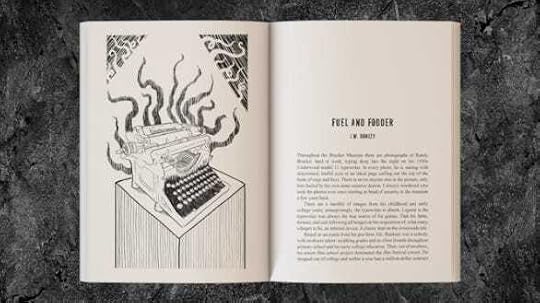
The audiobook is narrated by some of the authors, right? How hands-on were you, as editors, with the audiobook work?
Tim: That’s right, yep. Solomon Forse handled the technical aspects of audio production. And has done a great job. While I believe I have a face for radio, I don’t know much about the professional aspects of sound itself–beyond a very hearty “Sounds good!” Still, Jessica and I were very involved in expressing what we were looking for when it came to voice actors. We listened to recordings, gave a few ideas on what might work for a story, and were happy to support those already involved in the other aspects of the anthology offering their mellifluous tones if they so pleased our fancy.
JESSICA: I should also clarify that it’s not all authors as narrators! It’s 18 professional voice actors, two of whom happen to also be authors in the anthology. Most of them were found via the website Casting Call Club, whether in this round or some who have done work on several HOWLS anthologies. I was also grateful someone other than me was taking on the main audio role, because while I really respect audiobooks and their place in the market… I have yet to be able to finish one entire audiobook. Blame my audio-attention span!

I feel this hardcore—I only manage audiobooks on long drives, alone, with no one else in the car. What was your favorite part of working with this group of authors?
TIM: Much like the Two Bob’s from Mike Judge’s Office Space, the “Pleasure’s all on this side of the table.” It was an honor to work with such amazing talent. I don’t know if that’s a “favorite” thing, but it’s a thing–and I hold it quite sacred.
JESSICA: I don’t know if it was because the guidelines we wrote showed our visual for the anthology well, or just because we had a great group of submitters (it’s probably a mixture of both), but it was so exciting to open up all the stories and see how many had hit vibes we wanted, and vibes we didn’t know we wanted!
You have some phenomenal talent here—the HOWL Society anthologies always do. What new voices have you discovered for this one?
JESSICA: I am pretty sure this is the debut for three of our writers! (With apologies if I missed anyone or messed this list up) - RH Newfield, Nathan Schuetz, and LT Williams, and they all came out with absolute bangers for a first accepted piece. This is also long-time HOWLS designer/formatter M. Halstead’s writing credit in a HOWLS anthology so that’s a fun one to note! And one fun fact from the other side: there’s one writer who has been in all four HOWL Society anthologies - Lindsey Ragsdale (congrats on number 4, Lindsey!).
TIM: Ditto. I will also add that it is not uncommon for a writer’s first published piece to be in one of our anthologies. Jess’ first sold piece, a hell of a poem, was in Dark Ages. Mine was in Wreckage. You might say that Jess and I are a match made in a very particular way by one being published in one anthology and the other in the next. That, my friend, is the kind of bard’s tale accompanied by the plucked strings of a well-tuned lute.
My fourteen-year-old kid’s torn through all the other anthologies—they’re legit his favorite (for the record, he likes Howls from the Wreckage best, but it took him five minutes to decide). Why will he love Howls from the Scene of the Crime? For the record, we let him read Carson Winter. Or, at least, some of him.
JESSICA: He should love the various horror sub-genres and sometimes VERY different tones across a single theme like both Dark Ages (medieval) and Wreckage (disaster) had. The author blend should please him too as there are a bunch of authors you’ll see in other HOWL Society anthologies (including Carson Winter, of course!), plus fresh voices too.
TIM: Dear son of Eliza: Do you like eccentric cinephiles? Do you like the fear of the unknown? Do you like magic and the occult? What about forbidden tomes? The sparring of monsters and investigators who don’t take any guff? This and more awaits you. I’d hold that vote for favorite anthology until May 14, good lad. Your mother knows how to contact us.
Talk to me some about the illustrations! I’m always amazed about the quality of art in the Howl Society Press books.
JESSICA: Custom covers, gorgeous interiors illustrations. They are absolutely killer and I can’t wait for everyone to see the illustrations for each story and the portraits of all the contributors (sneak peeks are rolling through Twitter now!).
TIM: Thanks very much for the interview, Eliza! I think I’ve pontificated about as much as the internet will allow me to today. I look forward to locking minds with you again. I believe Jessica and I will both be at StokerCon this year–HOWLS has a table, you see. I plan to at least once dip my toes in those sparkling sands, if I can pull away from the dealer’s room. Do come say hello–not just Eliza, anyone, really. I shouldn’t be too difficult to find. Look for a very tall black man who seems a bit flummoxed. And then look past him to another tall black man–it is I. It is I…probably?
Thanks so much to Jessica and Tim! Visit the Howl Society Press Kickstarter Page for Howls from the Scene of the Crime: A Crime Horror Anthology to pledge your support and pick up some cool rewards. The book comes out on May 14.
February 29, 2024
Books that Did It For Me

Everyone has books that changed them. They’re books that made ah-ha moments, books that shifted their writing, offered them something, or gave them something to think about. I have several.
In no particular order, here they are.
The Prince of Tides, Pat ConroyI was eleven when I found The Prince of Tides in the back of my parents’ GMC Jimmy. We were driving back from the mountains, and I was bored, so I flipped it open and started reading. I found these words:
My wound is geography. It is also my anchorage, my port of call.
To understand their effect, you have to realize that I didn’t grow up in a house with William Shakespeare; I had never read Thomas Wolfe or F. Scott Fitzgerald. My childhood was full of plain books, and no poets dwelt under my parents’ roof—or maybe, reading those words, that’s when one was born. I honestly didn’t know that anyone could write like that:
When I was ten I killed a bald eagle for pleasure, for the singularity of the act, despite the divine, exhilarating beauty of its solitary flight over schools of whiting. It was the only thing I ever killed that I had never seen before. After my father beat me for breaking the law and killing the last eagle in Colleton County, he made me build a fire, dress the bird, and eat its flesh as tears rolled down my cheeks . . . He believed in the expiation of sin.
Let me reiterate that I was eleven years old. Mind. Blown.
My mother found the book and took it. Irony: she let me read everything Stephen King ever published, including It, but took The Prince of Tides because of the graphic rape scene (apparently, Apt Pupil was okay?!). I never forgot it, because it remained the only time my parents ever censored my reading. Conroy’s words lingered; I wrote snippets of his prose in a notebook—from memory; I scratched them in Catholic school cursive after she confiscated the book.
Years later, I found The Prince of Tides again and finished it. I stole Beach Music, too. I was applying to college at the time, and the kids in the novel go to the University of South Carolina. If it’s good enough for Pat Conroy, I thought, it’s good enough for me. My parents were after me to apply to a state school—I’d confined myself to Ivies and privates—and when USC’s Honors College dean personally called and offered me a giant scholarship, I accepted.
World War Z, Max BrooksI read this novel when it first came out, and it sticks with me for several reasons. It’s a perfection of a post-apocalyptic tale; Brooks hits on national character in a way that few other authors have ever managed. Because of South Africa’s history of apartheid, they have the Redecker Plan ready to go; because of their history of apartheid, Israel implements it perfectly (to their credit, they don’t discriminate between Palestinians and Jews, either, only humans and zombies). Americans have the Zombie Reality TV, but we’re also the first to fight them back—along with a guy who someone’s “pretty damn sure was Michael Stipe.”
This found-footage novel really shows the possibilities of voice. I was enraptured at the idea of using a multiplicity of characters to tell a story; Brooks is masterful at it. This novel deserves a lot more attention, from a craft standpoint, than it’s currently receiving.
Moby Dick, Herman MelvilleThis is the greatest horror novel ever written. This is, in fact, the greatest novel ever written. It’s beautiful, startling, terrifying, hilarious, and shocking in turns. Even boring, and that on purpose.
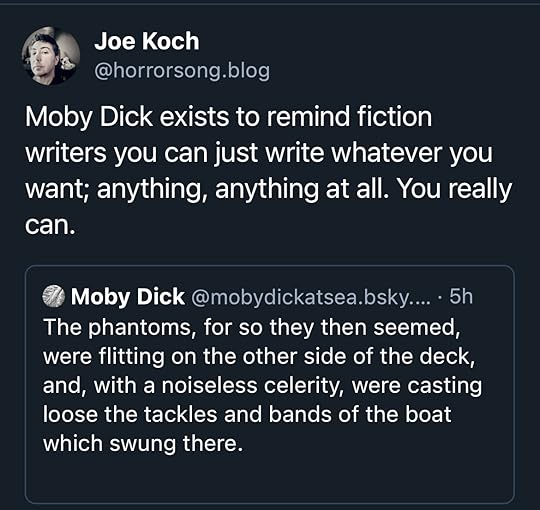
My friend Jonathan and I believe, I’d argue rightly, that pretty much everything can be related to Moby Dick. It’s a tome that can be used a sort of Bible, a touchstone, maybe a divination text. There’s an inherent mysticism to it. What is it but a battle between man and the unknowable, uncaring other, and what could be more horrifying? I don’t think it’s an accident that Chris Carter compares Mulder’s search for the truth to Ahab’s pursuit of the whale.
We can learn a lot, lyrically, from Melville.
Basically All of FaulknerAbsalom, Absalom! is my favorite, but I love it all. The Sound and the Fury is widely regarded as Faulkner’s best, probably rightly, since the voices are so stunning throughout (as are the voices in A Light in August), but my heart will always belong to that Gothic spiral of a novel. I love the image of Rosa Coldfield creeping to Sutpin’s Hundred with an ax in her hand, and also this, which I literally cannot read without crying, because it’s so fucking good:
Then in the long unamaze Quentin seemed to watch them overrun suddenly the hundred square miles of tranquil and astonished earth and drag house and formal gardens violently out of the soundless Nothing and clap them down like cards upon a table beneath the up-palm immobile and pontific, creating the Sutpen's Hundred, the Be Sutpen's Hundred like the oldentime Be Light. Then hearing would reconcile and he would seem to listen to two separate Quentins now-the Quentin Compson preparing for Harvard in the South, the deep South dead since 1865 and peopled with garrulous outraged baffled ghosts, listening, having to listen, to one of the ghosts which had refused to lie still even longer than most had, telling him about old ghost-times; and the Quentin Compson who was still too young to deserve yet to be a ghost but nevertheless having to be one for all that, since he was born and bred in the deep South the same as she was-the two separate Quentins now talking to one another in the long silence of notpeople in notlanguage, like this:
The plot of Absalom, Absalom! can be summed up in one, perhaps two sentences. It’s a miracle of structure; the plot is revealed as the novel spirals tighter and tighter, until it comes to a shattering, horrific conclusion. The prose is stunning. The setting is unforgettable. I listened to it as I drove to South Carolina recently, finished it, cried at the last line, then started it again. It’s everything a Gothic novel should be.
The Collected Stories of Flannery O’ConnorShe’s not mean, not really. Flannery O’Connor loves people, but she sees their inherent fallenness. She’s an astute observer of the inherent absurdity of man. Her stories are worth reading for their lovely shimmer of lunacy; O’Connor sees the raw red heart of the South and serves it up on a platter. Bible salesmen who steal legs, Temples of the Holy Ghost, raging bulls, monkeys at barbecue barns—O’Connor loves them all.
No shock that she’s from Savannah, the most Southern of all Southern cities, where the South reaches its illogical apotheosis of madness.
All of F. Scott FitzgeraldI have a story about Fitzgerald.
Much like Conroy’s The Prince of Tides, Fitzgerald’s The Great Gatsby blew my tender little psyche: In my younger and more vulnerable years my father gave me some advice I’ve been turning over in my mind ever since. The green lights, the beautiful little fool, the shirts . . . ! I knew I’d found a masterpiece. I was fifteen, and I fell in love.
A year later, I was admiring a painting in my friend Ceci’s house. “Zelda did that,” she said.
I planted my hands on my hips. “I only know one Zelda,” I said, “and you don’t have her paintings in your house.”
She gave me a strange look. “Uh, Zelda Fitzgerald is my great-grandmother,” she told me.
Ceci and I liked to mess with each other—we’d once convinced a friend that the term for Danish people was “Denmarkian”—so I threw her a look of sheer disdain. “No, she’s not.”
“Yes, she is,” Ceci said.
“No, she’s not,” I replied.
Ceci dragged me into the kitchen. “Mom, tell her who your grandmother is,” she demanded.
Her mother gave me an are-you-serious look. “Zelda Fitzergald,” Cecilia told me—the daughter of Scottie Fitzgerald, Cecilia Lanahan, whose son, my crush, was named Scott. One of my best friends, whom I’d known for years, was the great-granddaughter of freaking F. Scott Fitzgerald. Apparently everyone had known this but me, because I was (and am) chronically oblivious.
I went on to adore all Fitzgerald’s short stories and novels, leading to a very embarrassing moment, after college began, when the Rosses asked who my favorite writer was. I was forced to admit it was Fitzgerald.
It was only one of the many embarrassing moments surrounding Fitzgerald during college; when I picked USC, I didn’t know that it was home to the most illustrious Fitzgerald scholar in America, Matthew J. Bruccoli. I also didn’t know that he was involved in a lawsuit with the Lanahan family over the publication over early drafts of The Great Gatsby, titled Trimalchio in West Egg. Bruccoli was very interested to discover that I had grown up with Ceci and grilled me about the Rosses (I told him nothing); the Rosses were interested to know I took classes with Bruccoli (I told them everything). He was, in the main, a wonderfully disgruntled man, prone to shouting at Judy, his secretary, to get Sotheby’s on the phone. Ask how he was doing and he’d bark, “Still vertical!” When he passed, a tragedy for American letters, I ended up being among the people who cleaned out his office furniture. We discovered a racy romance stashed at the top of a bookshelf, and I kept it.
Later, I ate what I thought were grapes at the dilapidated hotel in Tryon, North Carolina where Fitzgerald wrote Tender is the Night. They were poisonous, and I threw them up before they killed me. I generally read all of Fitzgerald’s stories at least once a year. His descriptions of character are the standard to which I hold my own.
I could keep rambling, but those are the highlights. Of course, I read too much Stephen King too young. I was obsessed with David Eddings (later, I’d be devastated to realize how colonial and racist his novels are), Christopher Pike, and R. L. Stine. Latin American magical realism, especially Marquez and Cortazar, are huge influences of mine. When it comes to poets, I love Simic and Stevens.
And of course, I love House of Leaves, Twin Peaks, and all things Mike Flanagan.

February 18, 2024
Travels with Joey

“Virginia is the North of the South,” my friend Eva told me this morning over brunch in Columbia, South Carolina, and that’s true. Restaurants still serve sweet tea, and people still soften their consonants, but not nearly as much as the Deep South (the dark, troubled heart of America), where I pointed my car this weekend. I sort of had to. My best friend still lives there, and I’m deeply ashamed to say I miss it.
I Miss the LandscapeThe slanted February light broke my heart as I bumped down South Carolina’s poorly maintained roadways; it tilts farther into the golden, the tropical, than the light a scant four hundred miles north. I didn’t realize how wan Virginia’s winter light becomes. I miss the hope of a Carolina winter. It’s more of a brief chill than a proper freeze, a subtle graying instead of Virginia’s prolonged dreariness.
I missed the palmettos, the swamps, the hanging Spanish moss. You never grow out of a landscape. Your heart never leaves your own red dirt, your sandhills, or your home-like sucking quagmires (luckily, I moved into another swamp, but I miss my swamp, too, since my new one is tragically devoid of both bald cypresses and alligators). I stepped out of my car in Congaree National Park and its quiet smacked me across the face. I’d written about it, but I’d forgotten. I almost cried; I’d written about it Blood Cypress, from four hundred miles away, and I got it right:
“Stand on the edge of that swamp, right where water and land become uncertain brothers and that soupy air turns scum-sweet. Gaze back into those cypresses that seem old as bones. The distance goes gray and dim even when the sun shines. There’ll be cicadas shrieking and mosquitoes buzzing, but under it all you’ll hear the quiet. You’ll feel it then. The hair on your neck will rise, and you’ll know it’s watching. You’ll know it’s waiting, too, and if you step wrong it’ll suck you down into that muck with every other lost thing. It was there before us, and it’ll be there after. That’s the real reason they never cut that swampland.”
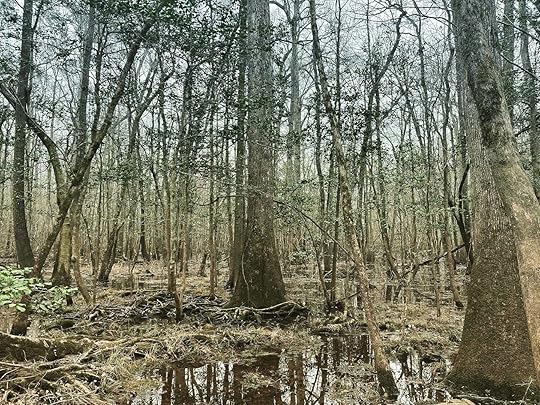
I knew I missed it, but I didn’t know I missed it that much.
I Also Missed the StoriesIf there’s a story in South Carolina, my best friend Joey knows it. He drove me through the back roads of Anderson County and reminded me of the story of the Laurens County KKK museum.
Downtown Laurens was once home to the Redneck Shop, which called itself the World’s Only Klan Museum. Run by John Howard, Jr., it terrorized the Black population of Laurens, SC, once a site of violent lynchings; the Klan, the Aryan Nations, and the American Nazi Party held meetings there. The shop opened not in the dark ages before the Civil Rights Era, but in 1996.
Rev. David Kennedy, whose great-great uncle Richard Puckett was victim of a brutal lynching in 1911, led a campaign of nonviolent resistance against the so-called museum. He won over the owner of the building, Michael Burden, who sold him the deed with the stipulation that he could take control after Howard died. The shop closed in 2012; Kennedy took control in 2017. Today, the property is becoming a diversity center, and I’m told that Burden attends the church where Kennedy preaches.
All the stories don’t end that well (obviously). When the Dalai Lama flew over South Carolina, he supposedly gazed sadly from the window of his plane. “That land is soaked in blood,” he said sadly.
And another: the Congaree Indians were so thoroughly wiped out by smallpox that nothing of their language remains. A rumor persists: They kept tame cranes in their villages. The cranes were pets, beloved, friendly as barnyard chickens. The secret of their domesticity was lost with the tribe.
Every place has their stories, but I miss my own.
I Kept It in CheckI was able to go back without stupidly overflowing nostalgia by looking at the place like a writer. Did I get the image of winter-dried kudzu right? Did I have the exit numbers correct? I told Joey early on that I couldn’t listen to music. “If I stay in craft mode, I’ll be okay,” I said. “If I give myself a soundtrack, I’ll fall out of craft mode and get introspective.”
So I took notes. I tried to remember the stories. I snapped pictures and bought palmetto pants (my friend Rhodes calls our state flag “the moon-spangled banner,” and I can get behind that). I grabbed a sweet tea at Lizard’s Thicket. I missed my kids and my husband and my Richmond crows. I tried not to look too hard at what’s changed. We stayed inside for two years during Covid, then we moved. Three and a half years changes a lot of things.
Sometimes I wonder if I belong anywhere—I don’t know Richmond well enough to feel at home, and home feels strange, alien. Well, I guess I’ll learn Virginia seems too chipper. But there’s not another answer, not really. You do the best with what you have, even when you feel dis-placed. Not that I feel that way about my house or immediate environs; I love my actual home and crows and immediate tree-neighbors more than the ones in SC, if only because I know them better. But Virginia is big.
Guess I’ll have to try anyway.
February 11, 2024
South Carolina Does It Again This Week

If we learned anything from the Murdaugh trial, it’s that Dick Harpootlian knows glitter from gold. Other than his disastrous decision to put Alex on the stand—which everyone and their housecat knows came from straight from Alex, against Poot-Poot’s strenuous objections—the trial was a masterpiece of jurisprudence on his part. Well, at least the opening statement. I mean, he worked what he had: a seersuckered Boss Hogg ruddied by time, privilege, and heart disease. Alex Murdaugh’s guiltier than Lucifier.
Thanks for reading Feral Swamp Life! Subscribe for free to receive new posts and support my work.
So when ol’ Poot-Poot proposed an amendment to a Second Amendment Bill in front of the South Carolina General Assembly, he knew exactly what he was saying.
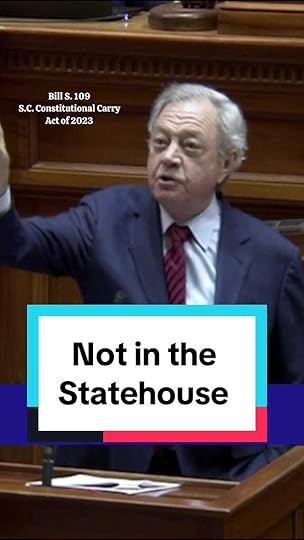 @scprogressivepoliticsYou didnt realize you won’t be able to carry at the statehouse? Bless your heart. #southcarolina #sclegislature #s109 #scconstitutionalcarry #constitutionalcarry #opencarry #dickharpootlian #scsenatorharpootlian [image error]Tiktok failed to load.
@scprogressivepoliticsYou didnt realize you won’t be able to carry at the statehouse? Bless your heart. #southcarolina #sclegislature #s109 #scconstitutionalcarry #constitutionalcarry #opencarry #dickharpootlian #scsenatorharpootlian [image error]Tiktok failed to load.Enable 3rd party cookies or use another browser
“Folks up there” [in the gallery], he says, should be able to “strap one on.”
What, what? Surely he doesn’t know what that sounds like—
“Senator from Spartanburg,” Harpootlian tells the legislative body, “It will also allow us to strap them on. So if someone starts firing, the rest of us can fire back . . . Why would you not want people with guns here? Walking around strapped on, that’s what it’s all about, the ability to defend yourself.”
The esteemed senator from the Midlands knows exactly what a strap-on is, y’all, and he’s using that verbiage on purpose. Yes, Southerners are insane, but he doesn’t really want guns in the gallery of the General Assembly. He wants to needle the Republicans.
It’s about guns. Guns, and traumatizing the religious right.
Nikki Goes FeralTricky “None of the Above” Nikki, trailing by an unimaginable margin in her home state, made headlines when she handed out copies of Trump’s mental competency test. What took you so long?
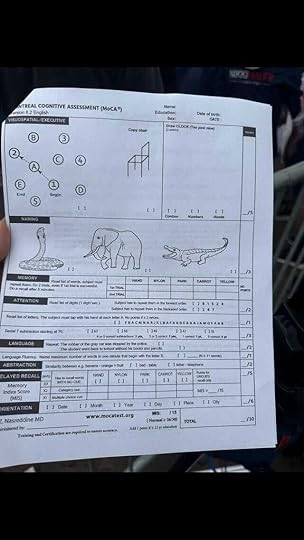
It’s a serious South Carolina move. It’s petty. It’s funny. It’s in service of a cause long-lost despite full knowledge of that failure—our state motto, Dum Spiro Spero, roughly translates to “I tilt at windmills.” Most importantly, Nikki’s gestures is a glimmer of truth from a source of near-limitless bullshit. We can’t decide if we want to cry, laugh, or rage, rage, against the dying of the light.
Her campaign’s doomed. But don’t worry, Nikki. I’m sure USC’s Darla Moore School of Business needs a titular head.

February 7, 2024
What I'm Working On

They always tell you to write what you know. Maybe luckily, or not, I’m intimately acquainted with a place where tapwater tastes like moss. BBQ barns fly Confederate flags there; the postal service is spotty, and our senior senator’s a notable pool shark. He used to eat dinner at one of my bestie’s houses, where he found the hump in their table immediately. The former senior senator used to eat dinner there too, before he croaked. He was a Dixiecrat. Our first apartment was at the corner where a drunk driver killed his daughter, and that’s how we gave people directions to our house. “We’re the first house up from the corner where Nancy Thurmond got hit,” we’d say.
“Oh, there,” friends would reply, though Nancy Thurmond died in the arms of the South Carolina Lieutenant Governor—who happened to be passing by—years and years before.
You’d write about it, too, if only because that one downtown gas station kept a tiger. Though it was before my time, Happy the Tiger eventually became the first animal at Riverbanks Zoo, and my kids spent their formative years climbing over his statue.
 There’s an inherent strangeness to the South.
There’s an inherent strangeness to the South.Flannery O’Conner’s “A Good Man is Hard to Find” is a classic for a reason, but it’s a linchpin to understanding Southern literature, and not for the reasons you think. Central to any understanding of the South is the lingering morass of history, our institutional racism, corruption, cronyism, and Lost Cause-ism. We can recite it like a nursery rhyme. But there’s a detail in that story that shows the effect all of them have when taken in total.
The tired family stops for lunch at one of those ubiquitous roadside BBQ barns. They have checked tablecloths, buffet-style service, and kitschy signs like “If You Can’t Stand The Heat, Get Out Of The Kitchen” and “God Don’t Make No Junk.” The kids eat outside. They watch the monkey in the trees, and the owner tells them about a recently escaped gang of murderers.
Did you catch it? There’s a fucking monkey in the tree. The monkey belongs to the owner. He’s a resident of the BBQ Barn. The monkey’s presence is not rationalized, and the narrative continues. You want to tell about the South? There it is: the monkey at the BBQ barn. It’s that shimmer of lunacy. When you live under the yoke of insanity for long, it becomes part of the scenery. The governor goes missing. Alex Murdaugh fakes his own suicide. Lady Chablis powders her face in her own cocaine and steps onstage.
If you find yourself paralyzed between laughter, rage, and weeping, the proper response is, “Bless your heart.”
So I have to write about it.My current work, Ninety-Eight Sabers, is a cross between Skinwalker Ranch, The Royal Tenenbaums, and the white side of Octavia Butler’s Kindred. It has something of Flannery O’Conner’s darkness, in the sense that she found South’s true and brittle heart, which has absurdity at the heart of its tragedy. In a land that runs historical plantations as theme parks, how do you deal with your unquiet ghosts?
There’s nothing more Southern Gothic than a literal time portal. The past isn’t really past. It’s not even past.
I found an important idea, the mirrored men, from my fourteen-year-old. In our accent, even I couldn’t quite understand what he was saying—it comes out something like “mird men” unless we’re really enunciating—and I had to have him write it down for me (if you’re having trouble imagining how this pronunciation trick works, imagine Jenna in Thirty Rock saying “the rural juror”). I combined that concept with the Greek concept of the Three Sisters, took a running leap, and started writing.
Ninety-Eight Sabers’ title comes from a incident in the novel, which actually happened. In a place which shall remain nameless, the state archives was junking a hundred Confederate sabers. A researcher wanted to save them, so he took every single one home. His whole house was slung with rusty Confederate sabers. I held that picture so clearly:
“They hung above the lintels, on the walls, atop the mantles, and lent the place a strangely martial air. We’ll be ready when the revolution comes, Sullivan used to think. He’d never questioned which one.”
I’m related to a few researchers, but I’m not related to this one. None of my relatives works with physical artifacts, and no Broadbent home is stacked with sabers. Anyway, my relatives would kill me if I put them in a book.
Want to know what kind of insanity I’m dealing with?Here are some links to get you started.
Reverend EX Slave, Who Set the Confederate Flag on Fire, Dead at 57
New Update on Murdaugh Family (one of my favorite Scary Mommy essays of all time; excuse the proofreader mistake. It was syndicated by Yahoo)
Alex Sanders on Saving Congaree: “We Had the Cannon Balls.”
Bonus clip: My favorite press conference. Mark Sanford admits his affair, cops to trip to Argentina. Watch for the face of the girl behind him, who was wandering the Statehouse at the time, then lingered in the background and grinned.

February 4, 2024
Ink Vine . . . Coming Soon!
I didn’t think I’d have a book this year. When I signed a deal for Blood Cypress with Jennifer Barnes at Raw Dog Screaming Press last summer, I was super-pumped . . . and with a publication date of 2025, in it for the long haul. I’d spend 2024 in my quiet corner. I’d help my RDSP buddies find reviewers. I’d cheer my friends from the sidelines. I’m happy in my corner. I write there. I watch my crows.
Rebecca Cuthbert very unceremoniously dragged me from it in early January when she accepted Ink Vine for Psychotoxin’s new feminist horror imprint, Psychotoxin Pink. I was 70K deep into a Southern Gothic novel, Ninety-Eight Sabers. I had to set it aside for more immediate concerns (I’ve added another several thousand words since then; I thought I’d have a fairly polished draft by now). Suddenly I’m finding my own reviewers, reading on The Horror Connection every week, and still helping my RDSP people with their stuff, in addition to pitching in with my new Psychotoxin people . . .
This was wildly unexpected.
 Ink Vine’s Beginning
Ink Vine’s Beginning I had an idea for Ink Vine a long time ago—a central conceit I played with in several different ways—but I knew I nailed it after the first scene. I had Emerald’s voice, and that was everything. Voice is super-important to me; I need a distinct voice to work whatever particular magic I’ve got. I have to hear a character. Somehow, it almost always happens, at least in longer-form work. I don’t know where Emerald came from, but when I reached for her, there she was, wholly herself, trying to buy a pack of Parliament Lights while the gas station attendant harasses her for dancing. I knew her right away.
Now I have to do author things.Once I finished with Rebecca’s edits, I thought I’d go back to my corner and pick up Sabers again. I was wrong. I did pick up Sabers again—78K and counting—but now I have to find my own reviewers; my email has picked up. I’m reading on The Horror Connection almost every week. I have to deal with publicity stuff; I have to keep up my website, my Substack, my Goodreads, my social media accounts . . .
This corner is getting a lot less corner-y.
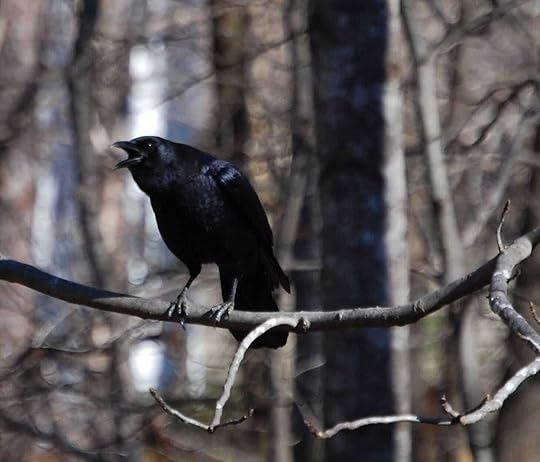
So I’ll see you around here a lot more often. Hit that subscribe button for fun email updates about our ongoing crow battles (a new murder moved in—Crime Family—and it’s getting ugly in Yard del Broadbent), book reviews, random musings, and yes: writing updates.
Thanks for reading Feral Swamp Life! Subscribe for free to receive new posts and support my work.



